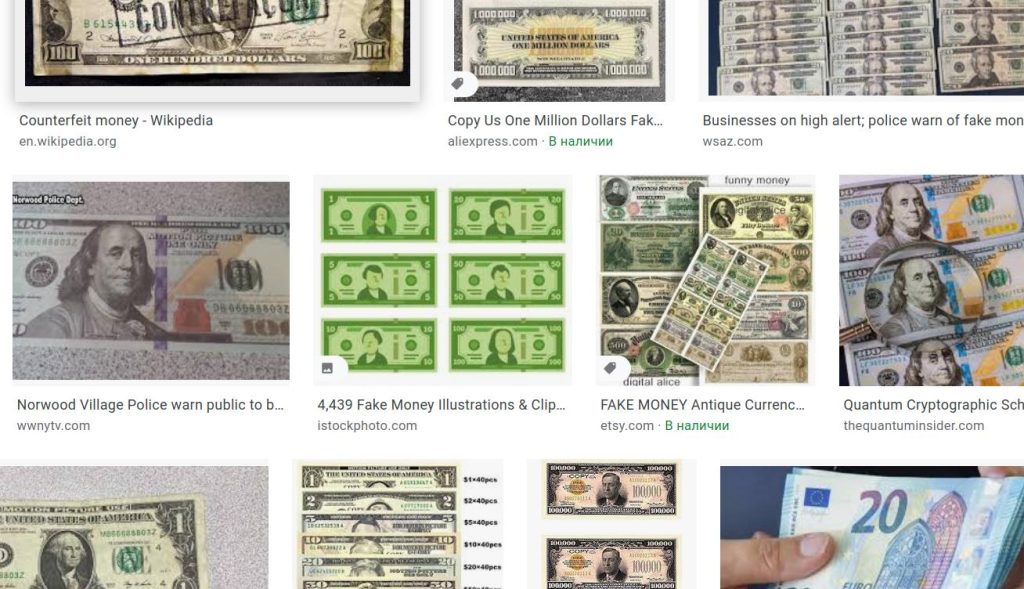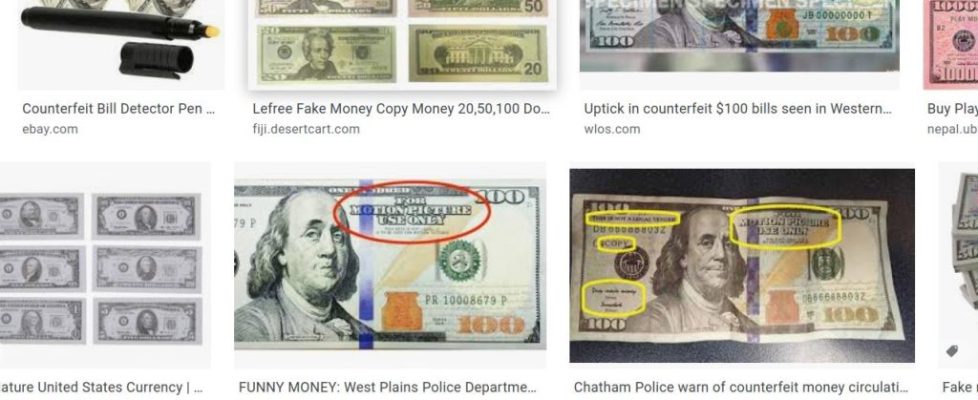Fake money that looks real
What do we mean when we talk about counterfeit money when we say “looks real”
The idea of fake money is not new. It has been around for centuries and has been used by everyone from counterfeiters to pranksters.
In the past, fake banknotes were printed on paper and often had a rough texture. But now, with the advent of digital printing technology, it’s easier than ever to create fake money that looks real. The goal of these counterfeiters is to fool people into accepting the fake banknotes as real currency in order to make a profit.
The concept of “looks real” can be divided into two parts:
- Fake money looks real for people
- Fake money looks real for ATM, vending machines …
These two types of bills can be very different from each other. For example, counterfeits for vending machines may not look like money at all, in such bills it is important that there would be exactly the security signs which ATM recognizes as money. And vice versa, banknotes which look like the real ones may never be accepted by an ATM.
Fake money, also known as counterfeit money, copy money, forged money, realistic replica money, or duplicated money (or simply fake bills), refers to either currency that has been created by someone without official authorization from a central bank or an officially produced object made to look like currency (or both).
Fake currency is not to be confused with replica currencies which are legal tender in their own right. Some fake notes are easy to spot, like black and white photocopies of bills, while others can be incredibly realistic unless you know what to look for.
This article will explore the history of fake money, the various ways it’s used, and the measures you can take to ensure that you know the difference between real and fake currency at all times.
How to Spot Fake Money
Fake money has been around since the beginning of money itself, when counterfeiters would take a substance and mix it with real currency in order to make more fake currency without investing anything themselves.
The problem has never gone away, but what exactly are fake notes, and how can you protect yourself from them?
In the modern world, counterfeit bills are an increasingly common problem for businesses and private individuals. Read more “Best Places to Pass Off Counterfeit Money“
1. Smoothness
First of all, there’s the one-hundred dollar bill test: if it feels too smooth to the touch, is unusually lightweight, or contains discrepancies in printing quality with fonts, like on the text THE UNITED STATES OF AMERICA, then chances are it’s counterfeit.
Elevated printing is something all real banknotes have, and it’s difficult for counterfeiters to imitate. Run your fingertips carefully over the note to check for raised printing.
You should feel the raised bumps on the bill. If you can’t feel this texture, you should check the bill more thoroughly.
2. Printing
A clear indication that a bill is false is when the borders, letters, or text are visibly hazy. Genuine bills have extremely fine patterns because die-cut printing plates are used to create them, giving them a three-dimensional appearance.
Typically, fake printers are unable to create prints with a similar degree of detail. Examine the note carefully, keeping a close eye on the limits to see if there are any ambiguous regions.
Authentic notes also have microprinting, which is small, precisely written text that is hidden. If the microprinting cannot be read even with a magnifying glass, it is probably fake.
Also, while most bills are printed on both sides, counterfeiters often print these details only on one side, which can easily be detected by holding the note up to the light.
3. Watermark
A watermark is a distinctive security characteristic of any authentic bill. The watermarks on a lot of the new notes are precise replicas of the bill’s face. On other banknotes, it only shows up as an ovoid mark. Remember the following:
- If it is a watermark on the front, it should match the bill’s face and be located on the right side of the bill, only visible when it is held up to the light
- If forgers bleach lower denomination bills and then reprint them with greater denominations, the face won’t match the watermark.
- If there is no watermark or the watermark can be seen without being held up to the light, the bill is most likely a fake.
Another way to tell is by looking at the watermark window; the security thread should say ‘The United States of America’ when held up to a light and bear a large Treasury seal. If there’s no watermark window or security thread at all, then it’s most likely not authentic.

4. Color of the Ink
Checking for color-shifting ink on the bill denomination in the bottom right corner is one of the best ways to determine whether a bill is genuine. All $5 bills and larger have had this security feature since 1996.
The numeral in the lower right-hand corner of a new series bill (apart from the new $5 bill) will change from green to black or from gold to green if you tilt the money back and forth.
5. Serial Number
The serial number is another aspect of a bill that can be examined to determine authenticity. If the alphabet doesn’t match the year printed on the note, the note is counterfeit.
This is because the letter that begins a bill’s serial number belongs to a particular year. Some examples of letter-to-year correspondence include L = 2009A, G = 2004A, E = 2004, I = 2006, J = 2009s
How Can I Protect Myself from Fake Currency?
Anyone, at any point in time, could fall victim to counterfeit money fraud. After all, how many of us take the time to inspect our currency for authenticity? However, if you receive a fake note and you don’t know where you got it from, then you will have lost money.
Thus, if you feel that counterfeit money fraud is possible where you are, make sure you check all bills before accepting them (especially larger denominations, such as the $100 bill). The best way to protect yourself from receiving fake bills is to take the following steps:
- Look closely at your bill; examine the texture of each note (carefully feel it with your fingers).
- Run a magnet over any $5 or higher denomination notes. If they are magnetic, then they are counterfeit!
- Don’t be fooled by photocopies, either. A clever counterfeiter can make you think you have a crisp new $100 bill when in reality, it’s just a piece of paper worth nothing to you.
- One sign of fraud might be excessive wear on the paper or excessive shine on the ink–a genuine US$100 bill should not show signs of wear or excess ink.
Many people try to pass off bogus bills as authentic. The U.S. Treasury Department has published a warning on its website about the growing number of counterfeit $100 bills being circulated around the country.
These fakes are often made in such high quality that only experts can tell them apart from real ones. Luckily, these simple ways can be used to spot a fake hundred-dollar bill.
Are There Any Security Features in Dollar Currency Notes?
There are many security features on U.S. dollar currency bills to make them difficult to counterfeit. To find out if your bill (or a bill that is being handed to you) is authentic, check it for the following features:
- There is a 3-D Security Ribbon that has microprinted words USA FIVE which can be seen when viewed at an angle.
- The note also has metallic copper ink, color-shifting ink, and several other printing details all over the note, which are extremely difficult to replicate.
- In addition, Benjamin Franklin’s watermark appears as you hold the bill up to a light.
- Finally, there is a security thread woven in with our nation’s Great Seal on the back of each note that glows blue when exposed to ultraviolet light.
In conclusion, it has become very difficult for people to create fake bills over time because they have so many different safety features.
So, what should you do if you get caught with a fake $20? You should turn the bill in to your local law enforcement office or send it to your nearest Federal Reserve Bank via mail or in person.
Why Do We Still Have Fake Currency Despite the Precautions?
The United States, which is the home of the most counterfeited bills in the world, knows this all too well. They have measures in place to thwart would-be counterfeiters. Still, this type of crime continues to grow even though security features like holograms and iridescent patches have made bills harder for fraudulent individuals to replicate.
The thing is, as new technology is used to identify counterfeits, there is also increasing technology to help create these counterfeit notes. Thus, it is an ongoing cycle of crime and protection.
One way the U.S. government (and other governments around the world) are countering this is the creation of new notes every once in a while. For example, the current $100 and $50 bills have noticeable differences in design.
The red coloring in the number 100 is lighter on the redesigned bills, and instead of blue, it is a more purple color. The new bills also have an iridescent stripe or what is called the security ribbon.
In addition to these changes, there are added features such as hidden images you can see by tilting the bill back and forth under a light. It’s made of plastic rather than paper, so they stay cleaner longer.
Lastly, the size of Benjamin Franklin’s eyes has been increased with one large eye near the big letter T and one smaller eye near the letter E.
Conclusion
Authorities all over the world are working tirelessly to create security measures to help people and companies spot counterfeit money when they see it, in addition to discouraging criminals from trying to make it.
If you reside in the United States, you can avoid being held accountable for any losses by alerting the Federal Reserve to counterfeit bills in circulation. You should report any errors that could indicate a bill is fake to the U.S. Currency Education Program.
